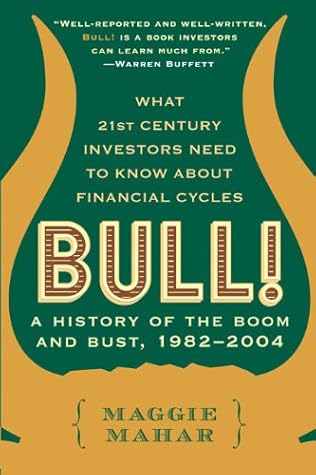More on this book
Kindle Notes & Highlights
by
Maggie Mahar
Read between
November 13 - November 16, 2020
the average individual investor
Meanwhile, in 1994, the final leg of the most magnificent bull market the world had ever seen was about to begin. Skepticism
Over the next four years the bull scaled one barrier after another: Dow 4000 (February 1995), Dow 6000 (October 1996), Dow 8000 (...
This highlight has been truncated due to consecutive passage length restrictions.
Dow 36,000.
Former Citicorp chairman Walter Wriston went so far as to declare markets “global plebiscites…voting machines [that] function by taking referenda.”
New York Times columnist Thom...
This highlight has been truncated due to consecutive passage length restrictions.
parliamentary system…[whose
pension funds,
bro...
This highlight has been truncated due to consecutive passage length restrictions.
basements via the I...
This highlight has been truncated due to consecutive passage length restrictions.
The metaphor fueled faith in “the wisdom of the market.” Who could question prices s...
This highlight has been truncated due to consecutive passage length restrictions.
AOL.
If investors actually picked stocks while seated in sealed voting booths, one might be able to correct for another’s mistakes.
401(k) inv...
This highlight has been truncated due to consecutive passage length restrictions.
Bill Seidman, CNBC’s chief economi...
This highlight has been truncated due to consecutive passage length restrictions.
the American consumer was headed: “You never know what the American public is going to do, but you do know tha...
This highlight has been truncated due to consecutive passage length restrictions.
the Zeitgeist.
CNBC’s breathless reports
dig deeply,
mull over a story.
Old-fashioned value investors such as Berkshire Hathaway chairman Warren Buffett still tried to assess a company’s prospects based on its “fundamental” value, measuring and comparing sales, profits, assets, and debt.
Đoạn này nói về Nhà Đầu Tư Gạo Cội Warrent Buffett thậm chí vẫn nghiên cứu về tình hình sức khỏe của doanh nghiệp trước khi mua cổ phiếu của nó.
both Wall Street and CNBC
“Over the long haul,”
“U.S. stocks always outperform other investments, returning, on average, 11 percent a year over ten years.”
Here was the fundamental, largely unacknowledged contradiction that haunted the People’s Market: Stocks were valued for the short term, yet investors were told tha...
This highlight has been truncated due to consecutive passage length restrictions.
“BUY AND HOLD”
Newsweek’s Jane Bryant Quinn was one of a handful of observers who paused to examine the idea of “the long term,” pointing out that the much-touted 11 percent average did not predict what would happen during a specific 10-year period.
the 10-year periods from 19...
This highlight has been truncated due to consecutive passage length restrictions.
72 y...
This highlight has been truncated due to consecutive passage length restrictions.
1926 to...
This highlight has been truncated due to consecutive passage length restrictions.
10 percent...
This highlight has been truncated due to consecutive passage length restrictions.
only about...
This highlight has been truncated due to consecutive passage length restrictions.
Everything depended on when he got in. And when he got out.
Holding for 20 years, the odds that he would earn the promised 11 percent improved, but still stood at only two in three—far from a guarantee.
In 2002, Quinn updated her numbers to include two years of a bear market.
In other words, if history is any guide, even the very long term investor should not count on 10 or 11 percent.8
Yet the mutual fund industry was inclined to embrace the “buy and hold” philosophy without complication in part because many in the industry believed it, in part because the strategy dovetailed so nicely with its own business plan.
“asset accumu...
This highlight has been truncated due to consecutive passage length restrictions.
“Suddenly, at many institutions, you started hearing about ‘asset gathering’—bringing new money into the company. Hell, I thought we were in the business of making money for our existing clients,” said Clyde McGregor, manager of The Oakmark Equity & Income Fund.9
old-fashioned firm
Besides, if customers withdrew their money every time a fund floundered, it would become all the more difficult to give new funds and new fund managers enough time to prove their mettle. “Buy and hold” made sense for everyone. Or so it seemed.
Thanks in large part to the 401(k)—a retirement plan that allowed workers to control their own investments—the mutual fund industry’s efforts at asset gathering succeeded beyond even its own most immodest dreams.
The 401(k)
401(k)s.
401(k) investors
2000,
401(k) investors
Struggling to keep pace with a roaring market, fund managers chased Wall Street’s darlings.
America Online
AOL,


